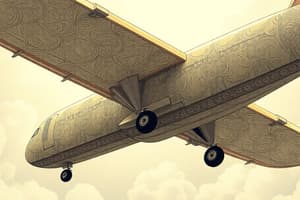Podcast
Questions and Answers
What can excessive braking cause in tailwheel-type airplanes?
What can excessive braking cause in tailwheel-type airplanes?
- Tire blowout
- Wheel locking
- Nose-over or ground loop (correct)
- Skidding
In modern high-speed jet aircraft, each wheel on a side is controlled by a separate pedal.
In modern high-speed jet aircraft, each wheel on a side is controlled by a separate pedal.
False (B)
Match the brake system component with its function:
Match the brake system component with its function:
Wheel-speed sensor = Detects change in deceleration rate Anti-skid control valve = Releases pressure before a skid occurs Control unit = Coordinates system operations
What can excessive braking cause in tailwheel-type airplanes?
What can excessive braking cause in tailwheel-type airplanes?
What effect can heavy braking have on large-diameter tires on small wheels?
What effect can heavy braking have on large-diameter tires on small wheels?
Is it possible to know when one wheel begins to skid in most modern high-speed jet aircraft?
Is it possible to know when one wheel begins to skid in most modern high-speed jet aircraft?
What is the purpose of applying only enough brake pressure to cause the tire to just begin to slip?
What is the purpose of applying only enough brake pressure to cause the tire to just begin to slip?
Applying brake pressure until the wheel starts to slip, but not skid, is the ideal _______.
Applying brake pressure until the wheel starts to slip, but not skid, is the ideal _______.
Match the following components with their functions:
Match the following components with their functions:
Flashcards are hidden until you start studying
Study Notes
Brake Control Concerns
- Excessive braking can cause a nose-over or ground loop in tailwheel-type airplanes
- Heavy braking can cause tires to slip on rims and pull out valves in large-diameter tires on small wheels
Modern Brake Systems
- Most modern high-speed jet aircraft have multiple wheels on each side, controlled by a single pedal
- No way to know when one wheel begins to skid
- Prompt corrective action needed to release locked-up wheel to prevent tire blowout and loss of control
Brake Friction and Tire Slippage
- Friction from brakes reduces wheel rotation rate and slows aircraft
- Friction between tire and runway slows aircraft, but too much can cause tire to slip instead of grip
- Slowing tire rotation rate too rapidly can cause tire to slip and lead to skid
- Applying only enough brake pressure to cause tire to just begin to slip produces maximum deceleration rate
- Maintaining optimum friction is difficult, as less brake pressure is needed as aircraft slows
Contamination and Runway Conditions
- Contamination like water, snow, or ice on runway reduces coefficient of friction between tire and runway
- Complicates maintaining right amount of brake pressure for maximum braking without excessive tire slippage
Manual Antiskid Control
- Pumping brakes to slow wheel and then releasing before wheel locks up is a simple form of manual antiskid control
- This method only works when control valves can operate very quickly
Ideal Braking Condition
- Applying brake pressure until wheel starts to slip, but not skid, is the ideal condition
- However, pilot has no indication when slip is reached and continues to increase brake pressure
Antiskid System Requirements
- Two features needed: wheel-speed sensor to detect change in deceleration rate and valve that can release pressure before wheel gets into a skid
- Retained pressure prevents brake-return system from pulling pressure plate all the way back, allowing brakes to reapply quickly
Modern Modulated Antiskid System
- Provides fastest wheel-speed recovery and minimum stopping distance on any runway surface
- Pilots need to depress brake pedals all the way to induce maximum braking
- If wheel decelerates too rapidly, indicating impending skid, some pressure is dumped into system-return manifold
- Control circuit measures time required for wheel to spin back up and applies reduced pressure to brake
Auto-Brake Feature
- Works in conjunction with antiskid system
- Automatically applies brakes when system senses weight on main wheels to produce one of several pilot-selected levels of deceleration
- Pilot can override and disarm autobrake system by applying manual brakes
Anti-Skid System Components
- Wheel speed sensors
- Anti-skid control valves
- Control unit
- These components work together without human interference to slow the aircraft without pedal input
Brake Control Concerns
- Excessive braking can cause nose-overs or ground loops in tailwheel-type airplanes
- Heavy braking can lead to tire slippage on rims and valve stem pull-out in large-diameter tires on small wheels
Modern Brake Systems
- Modern high-speed jet aircraft typically have multiple wheels on each side, controlled by a single pedal
- There is no way to detect when one wheel begins to skid
- Prompt corrective action is necessary to release locked-up wheels and prevent tire blowouts and loss of control
Brake Friction and Tire Slippage
- Brake friction reduces wheel rotation rate, slowing the aircraft
- Friction between the tire and runway slows the aircraft, but excessive friction can cause tire slippage instead of grip
- Rapidly slowing tire rotation rates can cause tire slippage and lead to skids
- Maximum deceleration rate is achieved by applying enough brake pressure to cause the tire to just begin slipping
- Maintaining optimal friction is challenging, as less brake pressure is needed as the aircraft slows
Contamination and Runway Conditions
- Runway contamination (e.g., water, snow, or ice) reduces the coefficient of friction between the tire and runway
- Contamination complicates maintaining the right amount of brake pressure for maximum braking without excessive tire slippage
Manual Antiskid Control
- Pumping brakes to slow the wheel and then releasing before it locks up is a simple form of manual antiskid control
- This method only works when control valves can operate rapidly
Ideal Braking Condition
- The ideal braking condition is when brake pressure is applied until the wheel starts to slip, but not skid
- However, pilots have no indication when slip is reached, and often continue to increase brake pressure
Antiskid System Requirements
- Two essential features are needed: wheel-speed sensors to detect changes in deceleration rates and valves that can release pressure before the wheel skids
- Retained pressure prevents the brake-return system from pulling the pressure plate all the way back, allowing brakes to reapply quickly
Modern Modulated Antiskid System
- This system provides the fastest wheel-speed recovery and minimum stopping distance on any runway surface
- Pilots must depress the brake pedals all the way to induce maximum braking
- If the wheel decelerates too rapidly, indicating an impending skid, some pressure is dumped into the system-return manifold
- The control circuit measures the time required for the wheel to spin back up and applies reduced pressure to the brake
Auto-Brake Feature
- This feature works in conjunction with the antiskid system
- It automatically applies brakes when the system senses weight on the main wheels, producing one of several pilot-selected levels of deceleration
- Pilots can override and disarm the autobrake system by applying manual brakes
Anti-Skid System Components
- Wheel speed sensors
- Anti-skid control valves
- Control unit
- These components work together without human interference to slow the aircraft without pedal input
Brake Control Concerns
- Excessive braking can cause nose-overs or ground loops in tailwheel-type airplanes
- Heavy braking can lead to tire slippage on rims and valve stem pull-out in large-diameter tires on small wheels
Modern Brake Systems
- Modern high-speed jet aircraft typically have multiple wheels on each side, controlled by a single pedal
- There is no way to detect when one wheel begins to skid
- Prompt corrective action is necessary to release locked-up wheels and prevent tire blowouts and loss of control
Brake Friction and Tire Slippage
- Brake friction reduces wheel rotation rate, slowing the aircraft
- Friction between the tire and runway slows the aircraft, but excessive friction can cause tire slippage instead of grip
- Rapidly slowing tire rotation rates can cause tire slippage and lead to skids
- Maximum deceleration rate is achieved by applying enough brake pressure to cause the tire to just begin slipping
- Maintaining optimal friction is challenging, as less brake pressure is needed as the aircraft slows
Contamination and Runway Conditions
- Runway contamination (e.g., water, snow, or ice) reduces the coefficient of friction between the tire and runway
- Contamination complicates maintaining the right amount of brake pressure for maximum braking without excessive tire slippage
Manual Antiskid Control
- Pumping brakes to slow the wheel and then releasing before it locks up is a simple form of manual antiskid control
- This method only works when control valves can operate rapidly
Ideal Braking Condition
- The ideal braking condition is when brake pressure is applied until the wheel starts to slip, but not skid
- However, pilots have no indication when slip is reached, and often continue to increase brake pressure
Antiskid System Requirements
- Two essential features are needed: wheel-speed sensors to detect changes in deceleration rates and valves that can release pressure before the wheel skids
- Retained pressure prevents the brake-return system from pulling the pressure plate all the way back, allowing brakes to reapply quickly
Modern Modulated Antiskid System
- This system provides the fastest wheel-speed recovery and minimum stopping distance on any runway surface
- Pilots must depress the brake pedals all the way to induce maximum braking
- If the wheel decelerates too rapidly, indicating an impending skid, some pressure is dumped into the system-return manifold
- The control circuit measures the time required for the wheel to spin back up and applies reduced pressure to the brake
Auto-Brake Feature
- This feature works in conjunction with the antiskid system
- It automatically applies brakes when the system senses weight on the main wheels, producing one of several pilot-selected levels of deceleration
- Pilots can override and disarm the autobrake system by applying manual brakes
Anti-Skid System Components
- Wheel speed sensors
- Anti-skid control valves
- Control unit
- These components work together without human interference to slow the aircraft without pedal input
Studying That Suits You
Use AI to generate personalized quizzes and flashcards to suit your learning preferences.



